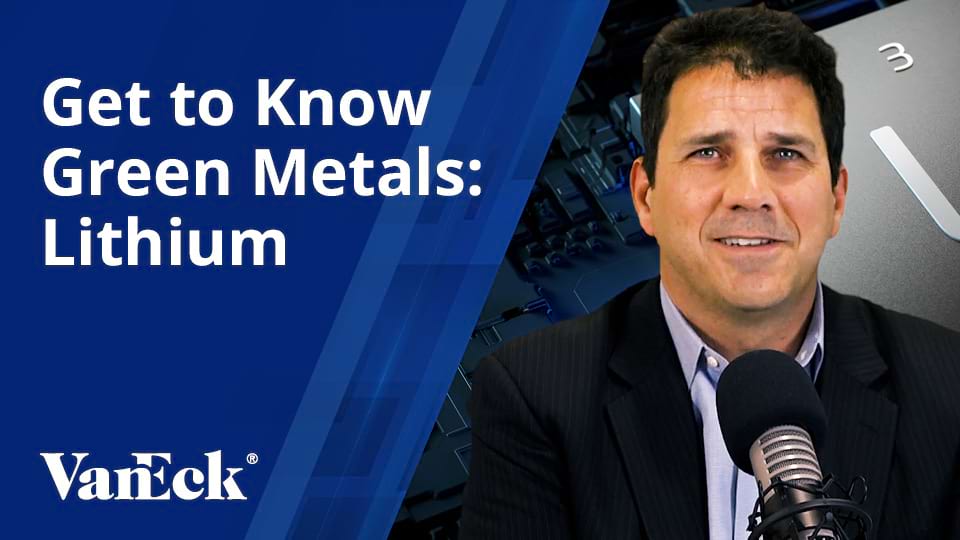Get To Know Green Metals: Supply Concerns
February 22, 2023
Read Time 6 MIN
Summary
- We believe the global resource transition is at an inflection point, creating long-term investment opportunities for several raw materials.
- It is essential to recognize the increased risk to the global supply of "green metals."*
- The risk of a weaker supply has the potential to be a defining issue in 2023.
Overview
In 2023 so far there have been frequent headlines about the risks that social, environmental, and geopolitical issues, ore grade, and drought bring to mining. These headlines span the globe and affect the supply of a number of green metals.
Copper
Global copper mine supply estimates for 2023 are approximately 23 million tonnes ("Mt")1, but we believe this figure is now under threat. In the past several months, supply estimates have been revised downward by 350 thousand tonnes ("kt"), or 1.5% of global supply. Thus, the supply/demand balance has swung from a 170 kt surplus to a 180 kt deficit.
The threats, by country (and related cause), in order of the severity of their potential risk to supply, are:
Peru (Social Unrest): At 2.4 Mt, or approximately 11% of global supply in 2022, Peru is the world's second-largest copper-producing nation. As the country’s worst and most violent political unrest in the past 20 years continues to escalate, mines have been forced either to halt or operate at partial capacity. Accordingly to The National Society of Mining and Energy2, about 30% of Peruvian copper production is at risk—a figure equivalent to approximately 3% of global supply.
This, then, begs the question of how the current instability will impact long-term investment in Peruvian mining as it could place 20 new projects (a combined 1.7 Mt of copper supply) at risk between 2026 and 2028.3
Copper Production 2022
Source: BMO Capital Markets as of December 2022.
Chile (Operational Concerns): Chile was the world's largest copper producer in 2022 at 5.3 Mt or approximately 25% of global supply. Operational issues are weighing on supply. Issues such as water shortages, deeper mines and ore grade deterioration have resulted in copper production falling well below the country’s prior five-year average (see chart below). The net annual impact on supply is estimated at approximately 350 Kt, equivalent to approximately 1.5% of global supply.
Chile Copper Production (Kt per Month)
Source Bloomberg, VanEck as of December 2022.
Meanwhile, state-owned Codelco, the world's largest copper producer, reported full-year 2022 copper production of 1.44 Mt, 10% less than in 2021. While, separately, mines such as Los Bronces and Collahausi (4% of global supply combined) have recently reduced their 2023 and 2024 production guidance.
Panama (Regulatory Bottlenecks): In December 2022, the government of Panama demanded that Cobre Panama (accounting for 350 kt or 1.6% of global supply in 2022) halt production after a deadline for a new mining contract and tax/royalty regime expired. Although operations have continued, negotiations are tough and could drag on, increasing the risk to global supply.
Zambia (Resource Rationing): In 2023, the country is projected to produce approximately 950 kt (4% of global supply) of copper. However, little rainfall in the current wet season limits electricity generation as the country derives some 75% of its electricity from hydropower. As a result, severe rationing of electricity supply to households and industries is now being rolled out, putting copper production at risk.
Lithium
United States (Land Rights Issues): General Motors announced it would invest $650 million in a U.S.-based lithium project.4 If built, this could become the largest lithium mine in the country and, on current figures, account for approximately 5% of global supply. It would also be a significant step toward helping secure domestic supply.
But this project, as with 70-95% of all known lithium, cobalt, nickel and copper deposits in the U.S., lies on, or within 35 miles of, Native American-owned land (Reservation).5 And, as such, it is the ancestral home of local indigenous communities and holds cultural, spiritual and historical significance, not to mention extreme importance as a wildlife habitat.
And, according to Daniel Cardena (CEO of Learning River, a National Native American STEM Initiative): "Having GM [General Motors] at the party does not alter the fact that this project has some major issues, especially with Native American sacred sites, and is culturally inappropriate.” Further, “…if the developers hope that having GM will somehow change the tide, they are really clueless."
Zimbabwe (Export Bans): In the first instance of what we think is a growing global issue, Zimbabwe's government has banned the export of raw lithium. Why? The answer: Beneficiation.6 As many governments, especially in Africa, export raw (un-beneficiated) minerals, they miss out on an excellent opportunity to create jobs and develop a local processing industry. According to the Zimbabwean government, the country has missed out on approximately EUR1.7B by exporting raw minerals and not processing them within the country. While, today, Zimbabwe is not a significant producer of lithium, it still holds some of the world's largest hard-rock lithium reserves and could become a critical source of new material.
Nickel
U.S. (Land Rights Issues): As part of what is being colloquially referred to as “NIMBY-ism” (“NIMBY” meaning “Not In My Backyard”), the Biden Administration has blocked the development of the Twin Metals mine in Minnesota by placing a 20-year moratorium on mining activity in the Superior National Forest. The Twin Metals project was set to produce nickel, copper and cobalt and sits atop one of the world's largest deposits of green metals (in this instance, deposits of nickel, copper and cobalt).
Philippines (Potential Export Bans): The world's second-biggest nickel supplier (11% market share) is contributing to the already-heightened supply uncertainties. Like Zimbabwe, it is considering either a tax or an outright ban on raw nickel exports to potentially develop downstream industries and create domestic employment opportunities.
Indonesia (Export Bans): In 2020, the world's largest nickel producer (22% market share) placed a total ban on nickel ore exports. Under the export ban, China invested heavily in and worked closely with Indonesia to secure refined nickel supply. The U.S. as well as other countries have become severely disadvantaged in achieving supply stability for electric vehicle batteries as a result.
Conclusion
Mining has a key role to play in decarbonizing the world. The applications and technology that will drive the transition to clean energy and decarbonization are minerals dependent and minerals intensive. Lithium, nickel, graphite, rare earths and copper are the most notable minerals.
Opening a mine takes many years and the industry is experiencing threats to mine production that have the potential to severely impact the supply of these green metals for some time.
To receive more Natural Resources insights, sign up in our subscription center.
Follow Us
Related Topics
Important Disclosures
Sources:
* “Green metals” are metals used in the applications, products and processes that enable the energy transition from fossil fuels to cleaner energy sources and technologies.
1 Goldman Sachs.
2 Bloomberg, Peru’s Violent Protests Imperil 30% of Its Copper Output, January 27, 2023.
3 UBS research.
4 Global Mining Review, GM invests in Lithium Americas to develop Thacker Pass mine, February 2, 2023.
5 Tribal Minerals Blog, Hello World! My First Post, February 1, 2023.
6 Beneficiation of an ore improves (benefits) its economic value before smelting or refining.
Please note that VanEck may offer investments products that invest in the asset class(es) or industries included in this blog.
This is not an offer to buy or sell, or a recommendation to buy or sell any of the securities/financial instruments mentioned herein. The information presented does not involve the rendering of personalized investment, financial, legal, or tax advice. Certain statements contained herein may constitute projections, forecasts and other forward looking statements, which do not reflect actual results, are valid as of the date of this communication and subject to change without notice. Information provided by third party sources are believed to be reliable and have not been independently verified for accuracy or completeness and cannot be guaranteed. VanEck does not guarantee the accuracy of 3rd party data. The information herein represents the opinion of the author(s), but not necessarily those of VanEck.
All investing is subject to risk, including the possible loss of the money you invest. As with any investment strategy, there is no guarantee that investment objectives will be met and investors may lose money. Diversification does not ensure a profit or protect against a loss in a declining market. Past performance is no guarantee of future performance.
Van Eck Securities Corporation, Distributor, a wholly owned subsidiary of Van Eck Associates Corporation.
Related Insights
Related Funds
Important Disclosures
Sources:
* “Green metals” are metals used in the applications, products and processes that enable the energy transition from fossil fuels to cleaner energy sources and technologies.
1 Goldman Sachs.
2 Bloomberg, Peru’s Violent Protests Imperil 30% of Its Copper Output, January 27, 2023.
3 UBS research.
4 Global Mining Review, GM invests in Lithium Americas to develop Thacker Pass mine, February 2, 2023.
5 Tribal Minerals Blog, Hello World! My First Post, February 1, 2023.
6 Beneficiation of an ore improves (benefits) its economic value before smelting or refining.
Please note that VanEck may offer investments products that invest in the asset class(es) or industries included in this blog.
This is not an offer to buy or sell, or a recommendation to buy or sell any of the securities/financial instruments mentioned herein. The information presented does not involve the rendering of personalized investment, financial, legal, or tax advice. Certain statements contained herein may constitute projections, forecasts and other forward looking statements, which do not reflect actual results, are valid as of the date of this communication and subject to change without notice. Information provided by third party sources are believed to be reliable and have not been independently verified for accuracy or completeness and cannot be guaranteed. VanEck does not guarantee the accuracy of 3rd party data. The information herein represents the opinion of the author(s), but not necessarily those of VanEck.
All investing is subject to risk, including the possible loss of the money you invest. As with any investment strategy, there is no guarantee that investment objectives will be met and investors may lose money. Diversification does not ensure a profit or protect against a loss in a declining market. Past performance is no guarantee of future performance.
Van Eck Securities Corporation, Distributor, a wholly owned subsidiary of Van Eck Associates Corporation.

